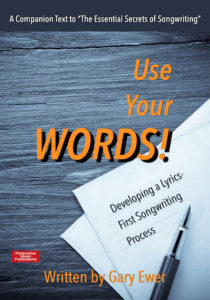 If you’re hoping to make lyrics a more important feature of your songs, you need to read “Use Your Words! Developing a Lyrics-First Songwriting Process.” Right now, it’s free with your purchase of “The Essential Secrets of Songwriting” 10-eBook Bundle.”
If you’re hoping to make lyrics a more important feature of your songs, you need to read “Use Your Words! Developing a Lyrics-First Songwriting Process.” Right now, it’s free with your purchase of “The Essential Secrets of Songwriting” 10-eBook Bundle.”
For most languages there is a written form and an oral form. You’ll notice this easily when you compare the words and sentence structure you’d use to write a formal letter to the way you’d speak to a friend at a party:
FORMAL WRITTEN: Could I please ask for a clarification of your return policy with regard to an order I recently placed at your store.
INFORMAL ORAL: Hey, are you guys meeting up at Joe’s Café later? ‘Cause I’m planning to be there too!
Song lyrics usually make greatest use of the oral style of language, particularly in the pop music genres. Informal, oral style has a natural flow that makes a more poignant, and very important, emotional connection to listeners. The stresses we place in the words we say is an important part of the natural rhythm of our language.
That’s why a poem doesn’t always make a great song lyric. That’s certainly not to say that poetry doesn’t make emotional connections. But the difference is that an important characteristic of pop songs is the immediacy of its effect. We need to pick up the mood and the effect right away.
But poetry will often take time to digest, to understand, and to feel its full effect. That time required to more fully digest a written poem is part of its charm. The best lyrics, by the way, are ones that can do both: offer an emotional connection that can be processed right away, while also offering a complexity that takes time to understand. Our understanding of a good lyric might actually change over time.
Preserving the Natural Flow of Language Within a Lyric
One of the most important jobs of setting a lyric is preserving the natural flow of the words. That means being mindful of the stresses, pauses and other features of the way we’d say those words.
Let’s take a well-known classic country-pop tune, “Take Me Home, Country Roads” (Bill Danoff, Taffy Nivert, John Denver) as an example. The chorus lines:
Country roads, take me home
to the place I belong,
West Virginia…
When you say the words several times, you pick up the natural flow, which means that you start to become aware of which words get a bit of weight, and which words are the ones we’d usually speak quicker and lighter:
COUN-try ROADS, TAKE me HOME
to the PLACE I be-LONG,
WEST Vir-GIN-ia…
The task for the songwriter is to set the words to music so that those natural stresses are still present when we hear them sung.
Why is that so important? Words are hard to understand if the natural stresses in the text are reversed or missing. And not only are they hard to understand, but the natural emotional effect of those words becomes greatly diminished if the syllabic accents aren’t where we expect them to be.
Songwriters have at least three ways of ensuring that music honours the natural flow of a language:
- Place stressed syllables on strong beats, and/or
- Make a stressed syllable longer, and/or
- Place stressed syllables higher in pitch.
When you look at the chorus words of “Take Me Home, Country Roads”, you’ll see all ways utilized. On the words “take me home”, the words “take” and “home” are longer in value than “me,” exactly the same way we’d likely say them. They’re also placed on strong beats within the music. On “I be-LONG”, the “long” syllable is placed higher in pitch, giving it special emphasis.
Mismatched stresses will interfere with a song’s natural flow, and it can be a primary reason for song lyrics being less effective than they might be. In order to be sure you don’t fall into this kind of trap, do the following for each song you write:
- Spend a good deal of time saying your lyric out loud, paying careful attention to stresses and pulses, and noting the syllables that you tend to spend a longer time on.
- Make note of where natural pauses happen in your lyric. In “Country Roads”, you feel a natural pause happening frequently: “Country roads [pause] take me home [pause] etc…” Do what you can to preserve those pauses when you set the lyric to music.
- Favour an oral form of speech over a written form. Choose your words to make their greatest emotional impact, particularly in the chorus.
 Written by Gary Ewer. Follow Gary on Twitter.
Written by Gary Ewer. Follow Gary on Twitter.
“The Essential Secrets of Songwriting” eBook bundle includes“Writing a Song From a Chord Progression”. Discover the secrets of making the chords-first songwriting process work for you.










